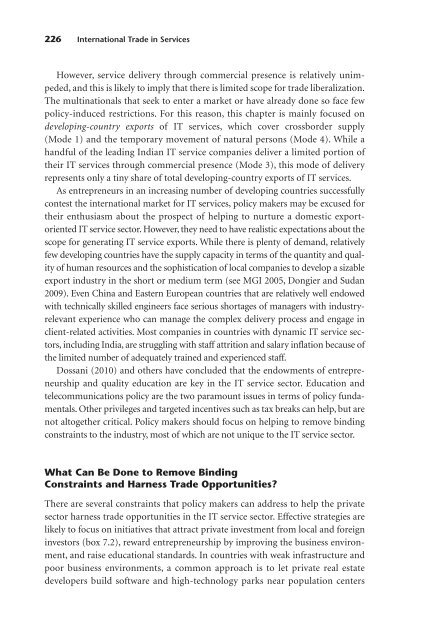International Trade in Services.pdf - DSpace at Khazar University
International Trade in Services.pdf - DSpace at Khazar University
International Trade in Services.pdf - DSpace at Khazar University
You also want an ePaper? Increase the reach of your titles
YUMPU automatically turns print PDFs into web optimized ePapers that Google loves.
226 <strong>Intern<strong>at</strong>ional</strong> <strong>Trade</strong> <strong>in</strong> <strong>Services</strong><br />
However, service delivery through commercial presence is rel<strong>at</strong>ively unimpeded,<br />
and this is likely to imply th<strong>at</strong> there is limited scope for trade liberaliz<strong>at</strong>ion.<br />
The mult<strong>in</strong><strong>at</strong>ionals th<strong>at</strong> seek to enter a market or have already done so face few<br />
policy-<strong>in</strong>duced restrictions. For this reason, this chapter is ma<strong>in</strong>ly focused on<br />
develop<strong>in</strong>g-country exports of IT services, which cover crossborder supply<br />
(Mode 1) and the temporary movement of n<strong>at</strong>ural persons (Mode 4). While a<br />
handful of the lead<strong>in</strong>g Indian IT service companies deliver a limited portion of<br />
their IT services through commercial presence (Mode 3), this mode of delivery<br />
represents only a t<strong>in</strong>y share of total develop<strong>in</strong>g-country exports of IT services.<br />
As entrepreneurs <strong>in</strong> an <strong>in</strong>creas<strong>in</strong>g number of develop<strong>in</strong>g countries successfully<br />
contest the <strong>in</strong>tern<strong>at</strong>ional market for IT services, policy makers may be excused for<br />
their enthusiasm about the prospect of help<strong>in</strong>g to nurture a domestic exportoriented<br />
IT service sector. However, they need to have realistic expect<strong>at</strong>ions about the<br />
scope for gener<strong>at</strong><strong>in</strong>g IT service exports. While there is plenty of demand, rel<strong>at</strong>ively<br />
few develop<strong>in</strong>g countries have the supply capacity <strong>in</strong> terms of the quantity and quality<br />
of human resources and the sophistic<strong>at</strong>ion of local companies to develop a sizable<br />
export <strong>in</strong>dustry <strong>in</strong> the short or medium term (see MGI 2005, Dongier and Sudan<br />
2009). Even Ch<strong>in</strong>a and Eastern European countries th<strong>at</strong> are rel<strong>at</strong>ively well endowed<br />
with technically skilled eng<strong>in</strong>eers face serious shortages of managers with <strong>in</strong>dustryrelevant<br />
experience who can manage the complex delivery process and engage <strong>in</strong><br />
client-rel<strong>at</strong>ed activities. Most companies <strong>in</strong> countries with dynamic IT service sectors,<br />
<strong>in</strong>clud<strong>in</strong>g India, are struggl<strong>in</strong>g with staff <strong>at</strong>trition and salary <strong>in</strong>fl<strong>at</strong>ion because of<br />
the limited number of adequ<strong>at</strong>ely tra<strong>in</strong>ed and experienced staff.<br />
Dossani (2010) and others have concluded th<strong>at</strong> the endowments of entrepreneurship<br />
and quality educ<strong>at</strong>ion are key <strong>in</strong> the IT service sector. Educ<strong>at</strong>ion and<br />
telecommunic<strong>at</strong>ions policy are the two paramount issues <strong>in</strong> terms of policy fundamentals.<br />
Other privileges and targeted <strong>in</strong>centives such as tax breaks can help, but are<br />
not altogether critical. Policy makers should focus on help<strong>in</strong>g to remove b<strong>in</strong>d<strong>in</strong>g<br />
constra<strong>in</strong>ts to the <strong>in</strong>dustry, most of which are not unique to the IT service sector.<br />
Wh<strong>at</strong> Can Be Done to Remove B<strong>in</strong>d<strong>in</strong>g<br />
Constra<strong>in</strong>ts and Harness <strong>Trade</strong> Opportunities<br />
There are several constra<strong>in</strong>ts th<strong>at</strong> policy makers can address to help the priv<strong>at</strong>e<br />
sector harness trade opportunities <strong>in</strong> the IT service sector. Effective str<strong>at</strong>egies are<br />
likely to focus on <strong>in</strong>iti<strong>at</strong>ives th<strong>at</strong> <strong>at</strong>tract priv<strong>at</strong>e <strong>in</strong>vestment from local and foreign<br />
<strong>in</strong>vestors (box 7.2), reward entrepreneurship by improv<strong>in</strong>g the bus<strong>in</strong>ess environment,<br />
and raise educ<strong>at</strong>ional standards. In countries with weak <strong>in</strong>frastructure and<br />
poor bus<strong>in</strong>ess environments, a common approach is to let priv<strong>at</strong>e real est<strong>at</strong>e<br />
developers build software and high-technology parks near popul<strong>at</strong>ion centers

















